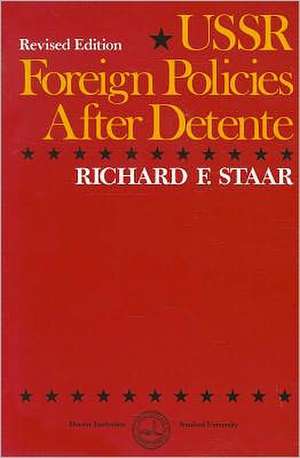USSR Foreign Policies After Detente
Autor Richard F. Staaren Limba Engleză Paperback – 31 mar 1987
Based largely on primary sources in the Russian language, this succinct volume covers the following aspects of Soviet foreign policy: world outlook, personalities and structures of the decisionmaking process, implementation of objectives, and a discussion of practices toward geographic regions as well as specific countries.
The author illustrates how messianic dogma still guides USSR foreign policy, as the Kremlin attempts to spread its ideology throughout the world. He identifies four of the most useful instruments employed by the Soviet Union: propaganda, espionage/active measures, military power, and foreign trade.
The volume next treats foreign policy objectives and concludes that they are not always uniform: in Eastern Europe, the Soviets work to maintain or improve an imperialist position; in Western Europe, to effect the withdrawl of U.S. troops, then to subvert NATO and the EEC, and finally to achieve a fundamental realignment of political forces.
Relations with the Third World are adapted to each country's progress along the "revolutionary-democractic path." Those with the United States, however, are controlled by the Soviet view of America as the "main enemy" and the greatest remaining obstacle to the final USSR objective: a world of Marxist-Leninist states.
The author illustrates how messianic dogma still guides USSR foreign policy, as the Kremlin attempts to spread its ideology throughout the world. He identifies four of the most useful instruments employed by the Soviet Union: propaganda, espionage/active measures, military power, and foreign trade.
The volume next treats foreign policy objectives and concludes that they are not always uniform: in Eastern Europe, the Soviets work to maintain or improve an imperialist position; in Western Europe, to effect the withdrawl of U.S. troops, then to subvert NATO and the EEC, and finally to achieve a fundamental realignment of political forces.
Relations with the Third World are adapted to each country's progress along the "revolutionary-democractic path." Those with the United States, however, are controlled by the Soviet view of America as the "main enemy" and the greatest remaining obstacle to the final USSR objective: a world of Marxist-Leninist states.
Preț: 114.93 lei
Nou
Puncte Express: 172
Preț estimativ în valută:
21.99€ • 22.72$ • 18.31£
21.99€ • 22.72$ • 18.31£
Carte indisponibilă temporar
Doresc să fiu notificat când acest titlu va fi disponibil:
Se trimite...
Preluare comenzi: 021 569.72.76
Specificații
ISBN-13: 9780817985929
ISBN-10: 0817985921
Pagini: 338
Dimensiuni: 152 x 229 x 23 mm
Greutate: 0.5 kg
Ediția:Revised edition
Editura: Hoover Institution Press
Colecția Hoover Institution Press
ISBN-10: 0817985921
Pagini: 338
Dimensiuni: 152 x 229 x 23 mm
Greutate: 0.5 kg
Ediția:Revised edition
Editura: Hoover Institution Press
Colecția Hoover Institution Press
Notă biografică
Richard F. Staar is a senior fellow at the Hoover Institution. He served as US ambassador to the Mutual and Balanced Force Reduction (MBFR) negotiations in Vienna, Austria. His areas of specialization include the Federation of Russia and East-Central Europe, military strategy, national security, arms control, and public diplomacy.
Descriere
Based largely on primary sources in the Russian language, this succinct volume cover the following aspects of Soviet foreign policy: world outlook, personalities and structures of the decisionmaking process, implementation of objectives, and a discussion of practices toward geographic regions as well as specific countries.
